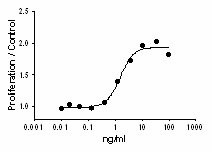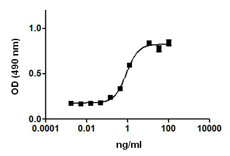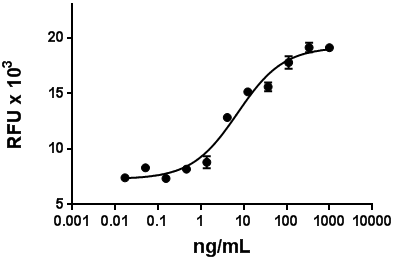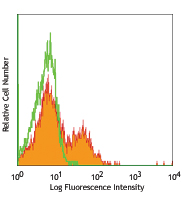- Regulatory Status
- RUO
- Other Names
- Interleukin-7, Lymphopoietin-1 (LP-1), Pre-B cell growth factor, Thymocyte growth factor
- Ave. Rating
- Submit a Review
- Product Citations
- publications

-

PHA activated PBL proliferation induced by mouse IL-7.
Mouse IL-7 was initially described as a pre B-cell growth factor expressed in bone marrow stromal cells. IL-7 is essential for normal murine B cell development, and plays a key role in regulating the homeostasis and function of the T-cells. The binding of IL-7 to its receptor induces dimerization of IL-7Ra and the common gamma chain (gc) which leads to activation of receptor associated tyrosine Janus kinases JAK1 (IL-7R) and JAK3 (γc). The activated JAK proteins in turn phosphorylate specific residues on the IL-7R creating docking sites for signaling molecules such as STAT5 and to a lesser extent STAT1 and STAT3. In adult mice, IL-7/IL-7R signaling up regulates expression of early B cell factor (EBF), and EBF in turn regulates expression of B cell-specific genes required for the transition from lymphoid progenitor to pro-B cells. Besides, IL-7 plays a role in the development of secondary lymphoid tissues. IL-7 is necessary to specify CD8 lineage differentiation during CD4/CD8 cell fate choice in the thymus by inducing expression of the transcription factor Runx3. IL-7 induces anti-apoptotic factors Bcl2 and Bcl-xL and inhibiting pro-apoptotic factors such as Bad and Bax. In this fashion, IL-7 induces cell activation, survival, and proliferation of T lymphocytes. In addition, IL-7 controls T-cell size and metabolism through the activation of PI3 kinase-dependent pathways and regulation of glucose metabolism. IL-7 also controls T cell–dendritic cell interactions that are essential for both T-cell homeostasis and activation in vivo. CD4 T cell lymphopenia increases the expression of circulating IL-7, and TGFb induces IL-7 downregulation.
Product DetailsProduct Details
- Source
- Mouse IL-7, amino acids Glu26 -Ile154 (Accession# NM_008371.4) was expressed in insect cells.
- Molecular Mass
- The 148 amino acid recombinant protein (with ADL-His9-SSGIEGR at N-terminus) has a predicted molecular mass of approximately 17 kD. The DTT-reduced and non-reduced protein migrates at approximately 20 kD by SDS-PAGE.
- Purity
- >95%, as determined by Coomassie stained SDS-PAGE.
- Formulation
- The protein was 0.22 µm filtered in 10 mM NaH2PO4, 150 mM NaCl, pH 7.2.
- Endotoxin Level
- Less than 0.01 ng per µg cytokine as determined by the LAL method.
- Concentration
- 10 and 25 µg sizes are bottled at 100 µg/mL. 100 µg size and larger sizes are lot-specific and bottled at the concentration indicated on the vial. To obtain lot-specific concentration and expiration, please enter the lot number in our Certificate of Analysis online tool.
- Storage & Handling
- Unopened vial can be stored between 2°C and 8°C for up to 2 weeks, at -20°C for up to six months, or at -70°C or colder until the expiration date. For maximum results, quick spin vial prior to opening. The protein can be aliquoted and stored at -20°C or colder. Stock solutions can also be prepared at 50 - 100 µg/mL in appropriate sterile buffer, carrier protein such as 0.2 - 1% BSA or HSA can be added when preparing the stock solution. Aliquots can be stored between 2°C and 8°C for up to one week and stored at -20°C or colder for up to 3 months. Avoid repeated freeze/thaw cycles.
- Activity
- ED50 =1.0 - 5 ng/ml, corresponding to a specific activity of 0.2 - 1 x 106 units/mg, as determined by PHA activated PBL proliferation induced by IL-7 in a dose dependent manner. Under this condition the bioactivity is equivalent
- Application
-
Bioassay
- Application Notes
-
BioLegend carrier-free recombinant proteins provided in liquid format are shipped on blue-ice. Our comparison testing data indicates that when handled and stored as recommended, the liquid format has equal or better stability and shelf-life compared to commercially available lyophilized proteins after reconstitution. Our liquid proteins are verified in-house to maintain activity after shipping on blue ice and are backed by our 100% satisfaction guarantee. If you have any concerns, contact us at tech@biolegend.com.
- Product Citations
-
Antigen Details
- Structure
- Cytokine
- Distribution
-
Thymic and bone morrow stromal cells, keratinocytes, dendritic cells, endothelial cells, intestinal epithelial, and epithelial goblet cells.
- Function
- IL-7 is essential for B cell production.
- Interaction
- Progenitor B and T cells, CD4-CD8- thymocytes, naïve and memory CD4 and CD8 T cells, and megakaryocytes.
- Ligand/Receptor
- Heterodimer IL-7Rα (CD127); γ-subunit (CD132) which shares component with IL-2, IL-4, IL-13, IL-15, and IL-21 receptors.
- Cell Type
- B cells, Hematopoietic stem and progenitors
- Biology Area
- Immunology, Stem Cells
- Molecular Family
- Cytokines/Chemokines
- Antigen References
-
1. Yokota T, et al. 1986. P. Natl. Acad. Sci. USA 83:5894.
2. Meier D, et al. 2007. Immunity 26:643.
3. Parish JK, et al. 2009 J. Immunol. 182:4255.
4. Saini M, et al. 2009. Blood 113:5793.
5. Park JH, et al. 2010. Nat. Immunol. 11:257.
6. Li WQ, et al. 2010. Mol. Cell. Biol. 30:590. - Gene ID
- 16196 View all products for this Gene ID
- UniProt
- View information about IL-7 on UniProt.org
Related FAQs
- Why choose BioLegend recombinant proteins?
-
• Each lot of product is quality-tested for bioactivity as indicated on the data sheet.
• Greater than 95% Purity or higher, tested on every lot of product.
• 100% Satisfaction Guarantee for quality performance, stability, and consistency.
• Ready-to-use liquid format saves time and reduces challenges associated with reconstitution.
• Bulk and customization available. Contact us.
• Learn more about our Recombinant Proteins. - How does the activity of your recombinant proteins compare to competitors?
-
We quality control each and every lot of recombinant protein. Not only do we check its bioactivity, but we also compare it against other commercially available recombinant proteins. We make sure each recombinant protein’s activity is at least as good as or better than the competition’s. In order to provide you with the best possible product, we ensure that our testing process is rigorous and thorough. If you’re curious and eager to make the switch to BioLegend recombinants, contact your sales representative today!
- What is the specific activity or ED50 of my recombinant protein?
-
The specific activity range of the protein is indicated on the product datasheets. Because the exact activity values on a per unit basis can largely fluctuate depending on a number of factors, including the nature of the assay, cell density, age of cells/passage number, culture media used, and end user technique, the specific activity is best defined as a range and we guarantee the specific activity of all our lots will be within the range indicated on the datasheet. Please note this only applies to recombinants labeled for use in bioassays. ELISA standard recombinant proteins are not recommended for bioassay usage as they are not tested for these applications.
- Have your recombinants been tested for stability?
-
Our testing shows that the recombinant proteins are able to withstand room temperature for a week without losing activity. In addition the recombinant proteins were also found to withstand four cycles of freeze and thaw without losing activity.
- Does specific activity of a recombinant protein vary between lots?
-
Specific activity will vary for each lot and for the type of experiment that is done to validate it, but all passed lots will have activity within the established ED50 range for the product and we guarantee that our products will have lot-to-lot consistency. Please conduct an experiment-specific validation to find the optimal ED50 for your system.
- How do you convert activity as an ED50 in ng/ml to a specific activity in Units/mg?
-
Use formula Specific activity (Units/mg) = 10^6/ ED50 (ng/mL)

 Login / Register
Login / Register 














Follow Us